Contents
Before we get into the many rice health benefits, let us learn a little more about this all-important food. Rice has been known as the: “bread of Asia.” Most of the world’s rice production, some five hundred million metric tons a year, is generated in humid regions of the Far East: India, Bangladesh, Indonesia, and China. Rice is eaten daily in these countries; a meal without this grain is unimaginable.
The Greeks and Romans knew extraordinarily little about rice. The Arabs introduced it to Europe through the Iberian Peninsula. The Dutch took it to North America in the seventeenth century and later to Africa. Thus, it became the most widely cultivated grain in the world.
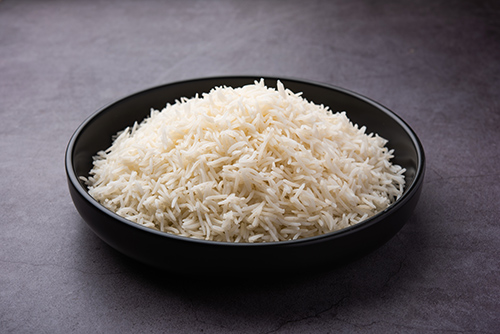
Rice Nutritional Facts
Despite its popularity in dishes, rice is the least nutritious grain, particularly if it is refined (polished).
PROTEINS: Rice’s protein content is the lowest of any grain. No variety contains more than seven percent, much less than oats’ 16.9 percent or wheat’s 13.7 percent. It is worth noting that rice has no gliadin, the protein that constitutes wheat gluten. This characteristic makes rice suitable for those with celiac disease. Rice protein is lacking in tryptophan and lysine, two essential amino acids.
Nevertheless, combining legumes with rice, which tends to have excess substances, solves this problem. Rice and lentils, for example, provide the body with the required amino acids to create a complete protein. Cow or soymilk proteins also merge well with rice.
FATS: White rice contains no fat, and the bulk that it does have is concentrated in the bran and germ. Whole-grain rice only contains 2.7 percent fats, less than oats (6.9 percent) or corn (4.3 percent). Although scarce, rice’s fatty acids are unsaturated and of great biological value.
CARBOHYDRATES: These constitute four-fifths of the weight of a grain of rice. All these carbohydrates are in the form of starch.
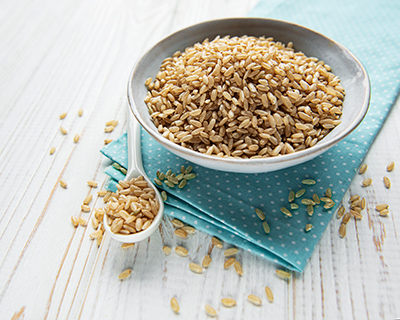
VITAMINS: As with other grains, rice lacks vitamins A, and C. Whole-grain rice contains significant amounts of vitamins B1 and E. However, white rice has little of these vitamins. Eating white rice as a diet staple produces the serious disease of beriberi. When the diet is more varied by other vitamin B1-rich foods such as oil-bearing nuts or legumes, there is less risk of deficiency. However, it is best to eat whole-grain or parboiled rice, which contains more significant vitamin B1, including B2, B6, and niacin.
MINERALS: With 1 mg/100 grams of sodium, rice is among the foods lowest in this mineral. This makes it specifically appropriate for those with hypertension or cardiovascular conditions. Whole-grain and white rice contain other minerals such as iron, magnesium, calcium, and potassium, although in modest amounts.
Rice may be viewed nutritionally as a simple food that is easy to assimilate and creates a feeling of satiation. Still, white rice (refined) should not comprise the diet’s basis since it lacks many vitamins and minerals. Rice, whether white or whole grain, must be combined with other foods such as legumes, vegetables, or milk to increase its nutritional capacity.
Rice Health Benefits
Rice is beneficial in the following cases:
1. Rice health benefits (ANY CASE OF DIARRHEA): Rice boiled with a bit of oil and salt is, together with the apple and yogurt, one of the first solid foods after a case of diarrhea of any cause. Its ease of digestion and mild astringent action make rice exceptional for restoring intestinal mucosa after colitis or gastroenteritis.
2. Rice health benefits (DIARRHEA in INFANTS): Rice water is the ideal fluid for oral rehydration in case of diarrhea, particularly for children. It may be given as the only beverage, adding a few drops of lemon juice if desired. In addition to providing necessary fluid (rehydration), rice water provides mineral salts, particularly potassium and complex carbohydrates (starch), which stop diarrhea.
A study at the University of Costa Rica compared the effect of classic glucose-based rehydration solutions with rice water. Infants suffering from acute diarrhea and dehydration improved much sooner when given rice water than glucose water.
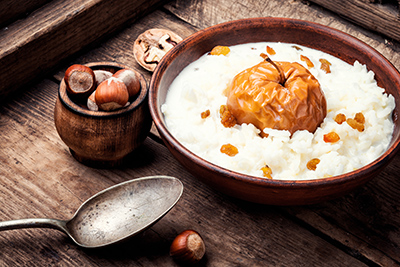
3. Rice health benefits (HIGH BLOOD PRESSURE): Because rice is a low-sodium food, it is advantageous in cases of hypertension. SODIUM is a mineral with an excellent capacity for fluid retention (as occurs with common salt and sodium chloride). Excess sodium (edema) and increases blood volume. This causes an increase in blood pressure. The more sodium or salt is taken in, the higher the risk of hypertension.
It must be remembered that all animal-based foods (milk, cheese, eggs, fish, and meat) are high in sodium, while fruits, vegetables, and legumes contain little sodium. Rice, alone or with other plant-based foods, constitutes a fundamental element of a low-sodium diet.
4. Rice health benefits (CARDIAC DISEASE): When the heart fails to perform its role (cardiac failure), fluids accrue in the tissues, and the kidneys fail to eliminate adequate urine. This situation is worsened by consuming sodium-rich foods, which retain even more fluid and produce more edema. Because of this, a low-sodium diet is required in cases of cardiac failure. Rice is an excellent food in this case. The fact that rice has no fat makes it even more valuable in cases of coronary disease.
5. Rice health benefits (HIGH CHOLESTEROL): Whole-grain rice impedes the absorption of biliary acids in the intestine because of its fiber content. These acids are the raw material used by the liver to create cholesterol. Since rice contains almost no fat and, indeed, no cholesterol, eating it in whole-grain form has the beneficial effect of lowering blood cholesterol levels.
6. Rice health benefits (EXCESS URIC ACID): Because of its shallow protein content and alkalizing effect, rice is highly suggested in cases of additional uric acid in the blood, which may manifest as arthritis or gout. Naturally, it must be eaten either alone or with other plant-based foods.
A Rice-Based Diet for Anemia
Studies have shown that rice-based diets, as in some Asian countries, can result in anemia. This fact is attributed to rice’s shallow iron content. Whole-grain rice has more of this mineral, but it is not well absorbed because of the phytates in the bran. However, there is no need to fear anemia in rice-rich diets if eaten with vitamin C-rich fresh fruits and vegetables.
This physiological fact is well known and was again demonstrated in a study at the University of Bangkok (Thailand): vitamin C enhances iron absorption from vegetable sources. And its effect more than compensates for the inhibiting effect of the bran phytates. Eating rice with vegetables and lemon is highly beneficial from a nutritional standpoint.
Types of Rice
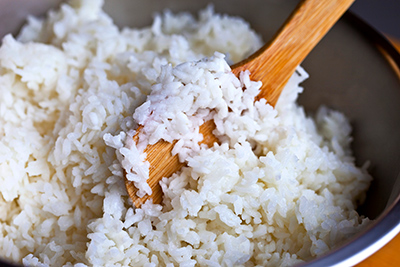
SHORT GRAIN RICE: The grains of this rice open during cooking, which makes it pasty. It is highly valued in pastry and confectionary, particularly for making rice pudding.
SHELL RICE: Also called paddy or raw rice. This is rice, just as it comes from the field. It contains all the grain elements, including the outer covering (shell, glume, or hard bran), rich in silicon and cellulose. Because it is so hard, it is not appropriate for human consumption.
LONG GRAIN WHITE RICE: The grains of this rice remain whole and fluffy during cooking. It is preferred for cold dishes such as rice salads.
WHOLE-GRAIN RICE: This type of rice is richer in vitamins and minerals than white rice but takes more time to cook and is tougher to chew. It is easier to prepare it if it is soaked for hours before cooking. A few drops of lemon juice in the cooking water make it softer. Some so-called whole rice is semi-whole grain or brown rice since the outer layer (glume or bran) is removed to make it more digestible. This outer layer also contains phytic acid, interfering with iron absorption and other minerals.
PARBOILED RICE: This hydrothermally treated whole-grain rice has been slightly refined. It is easier to eat than whole-grain rice and retains most of its vitamins. It remains very fluffy and does not become pasty when reheated. Although precooked, it requires a longer cooking time than white rice.
Rice Scientific Facts
- Scientific name: Oryza sativa L.
- French: Riz.
- Spanish: Arroz.
- German: Reis.
- Description: The grain of the rice plant of the botanical family Gramineae. The grains consist of the shell, pericarp, glume, and the endosperm or grain itself.
- Environment: This is the most widespread grain in the world. It is heavily cultivated on the five continents in wet areas in temperate or hot and humid regions. ” mountain rice” also requires less moisture than rice grown in paddies, but its quality and production are lower.
How to use and Prepare Rice
- COOKED: Rice cannot be eaten raw but is the primary ingredient in various recipes. From a nutritional standpoint, it combines particularly well with vegetables, legumes, and cows or soy milk.
- RICE CEREAL: Rice prepared this way is used with other grains in muesli. Whole-grain rice is used for this purpose.
- RICE WATER: This is prepared by boiling two tablespoons of rice in one liter of water until the rice disintegrates. Let the liquid stand until cool, then strain. It may be flavored by adding a cinnamon stick and/or lemon peel or a few drops of lemon.
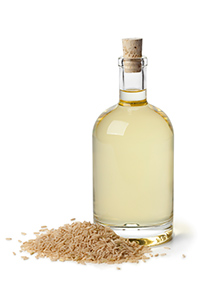
Rice Bran Oil
India is the second producer of rice in the world. To utilize the enormous amount of bran left after refining, the Indian rice industry began extracting oil from this bran. Its use is increasing in India, and it is reaching other countries. Rice bran oil has a similar composition to that of peanuts. It is rich in phytosterols and tocopherol (vitamin E), and according to studies, it is an excellent hypolipidemic capable of reducing blood cholesterol. What began as a simple rice by-product is becoming a valid alternative to traditional oils.
Rice Fortunes and Misfortunes
Despite being the staple food of a large part of humanity, rice’s cultivation and consumption have been overshadowed by two huge misfortunes over the last centuries:
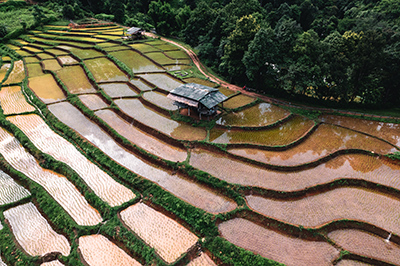
MALARIA: From the sixteenth century, many Southern European scientists viewed rice with contempt because its cultivation was associated with malaria. At the time, the real cause of this disease was unknown, and doctors verified that most cases were found around flooded rice paddies.
Opposition to rice crops reached such heights within public health circles that in 1860, a royal proclamation limited its cultivation in Spain to specific, well-defined zones called “cotos.” Farmers in the ancient kingdom of Valencia, a prime rice-growing region, reduced production, but malaria cases did not diminish. On the other hand, it was known that other countries where rice was also grown in paddies did not suffer from malaria.
Why was this? Investigators concluded that the carrier of malaria was not rice but the anopheles mosquito that swarmed around the paddies. The use of pesticides, even with their attendant ecological risks and a specific type of fish that eats mosquito larvae in the water, eliminated malaria from the areas around the rice paddies.
BERIBERI: Just when the malaria fears concerning rice were being conquered, another dark misfortune emerged regarding this singular grain: A diet based on white rice became associated with a disease that the inhabitants of Ceylon (today’s Sri Lanka) called beriberi (beri means “weakness” in the local language). Near the end of the 19th century, European colonizers introduced the practice of refining rice to the Far Eastern countries.
Beriberi, unknown to that point, became endemic in the Philippines, Japan, and other Asian countries that based their diet on this grain. Although the cause of beriberi was unknown, and some physicians thought it was an infectious disease, it soon became apparent that it had something to do with the refinement of rice. In 1926, the Dutch chemists Donath and Jansen discovered a substance in rice bran called vitamin B1.
Beriberi results from the deficiency of this substance in white or refined rice, not the rice itself. Simply eating whole-grain rice, returning to what had been the custom throughout Asia before the arrival of the Europeans, solved the problem.
Rice maintains its greatness as the most widespread grain on earth. It has also recaptured its fortunes after casting off the dark shadows that threatened it.
DISCLAIMER: All content on this website is presented solely for educational and informational objectives. Do not rely on the information provided as a replacement for advice, diagnosis, or treatment from a qualified medical expert. If you are pregnant, nursing, or have any preexisting medical concerns, talk to your doctor before using any herbal or natural medicines.
REFERENCES
- George D. Pamplona-Roger, M.D. “Encyclopedia of Foods and Their Healing Power.” George D. Pamplona-Roger, M.D. Encyclopedia of Foods and Their Healing Power. Trans. Annette Melgosa. Vol. 2. Chai Wan: Editorial Safeliz, 2005. 225, 226, 227, 228. Print. [Rice health benefits]
- Nutrients Journal: https://www.mdpi.com/2072-6643/12/4/951/htm
- Consumer Reports: https://www.consumerreports.org/cro/magazine/2015/01/how-much-arsenic-is-in-your-rice/index.htm
Last update on 2025-06-04 / Affiliate links / Images from Amazon Product Advertising API





